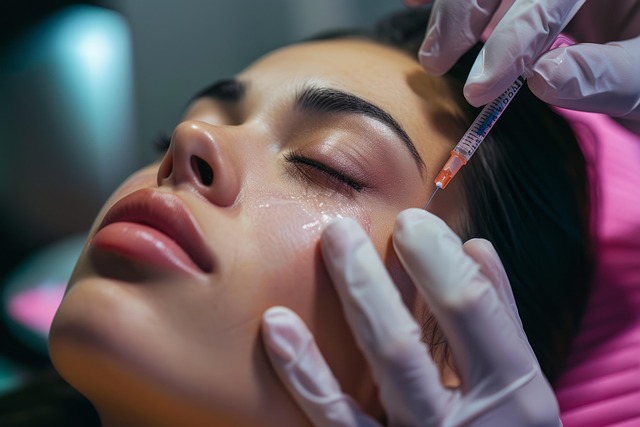Botox, derived from Clostridium botulinum, is a neurobiological tool used in cosmetics and medicine. It blocks nerve signals to muscles, causing temporary paralysis and reducing dynamic facial wrinkles. In aesthetic practices, it relaxes specific muscle groups, minimizing age-related lines. Therapeutically, it treats involuntary muscular contractions. When injected, Botox inhibits acetylcholine release, leading to muscle relaxation and smoothing fine lines. Popular for dynamic wrinkles like frowns and crow's feet, it offers a non-surgical, subtle yet noticeable lift. Safety and effectiveness are key concerns; choosing an experienced provider is crucial. Side effects may include redness or swelling, but open communication ensures informed decisions with realistic expectations.
“Unraveling the science behind Botox offers a profound insight into its role as a game-changer in cosmetic treatments. This article explores how this neurotoxic protein works its magic, specifically targeting facial muscles responsible for wrinkle formation. We delve into the mechanism of muscle relaxation and its effectiveness in reducing signs of aging. With a focus on safety and considerations, we guide readers through the process, ensuring they understand Botox’s potential as a non-invasive solution for achieving a youthful complexion.”
Understanding Botox: A Neurotoxic Protein's Role
Botox, a well-known name in cosmetic treatments, is not just a fleeting trend but a scientific marvel with deep roots in neurobiology. At its core, Botox is a protein produced by a bacterium called Clostridium botulinum. Surprisingly, this same toxin has found its way into dermatological practices as a tool for treating facial wrinkles and various muscular conditions. The protein’s unique property of blocking nerve signals to muscles causes temporary paralysis, leading to the reduction of dynamic lines on the face—the primary application of Botox in the aesthetics industry.
When used therapeutically, Botox is injected into specific muscle groups to relax them, thereby preventing the formation of wrinkles caused by repeated facial expressions. This procedure offers a non-surgical alternative for individuals seeking to mitigate the signs of aging or those with medical conditions leading to involuntary muscular contractions. Understanding the science behind Botox’s neurotoxic properties is key to appreciating its role in both cosmetic and therapeutic contexts for facial wrinkle reduction.
How Botox Works: Muscle Relaxation in Action
Botox, a popular cosmetic treatment for facial wrinkles, operates by blocking nerve signals to specific muscles. When injected into targeted areas, Botox inhibits the release of acetylcholine, a neurotransmitter responsible for muscle contraction. This action leads to a state of temporary muscle relaxation, which smooths out fine lines and wrinkles on the face. The result is a more youthful appearance as skin gains a refined and rejuvenated look.
This procedure offers significant benefits for those seeking to reduce the visibility of dynamic wrinkles caused by facial expressions. By relaxing specific muscles, Botox can prevent over-activation that leads to recurring wrinkle formation. It’s particularly effective for treating frown lines, crow’s feet, and forehead wrinkles, providing patients with a more relaxed and balanced facial expression.
Targeting Facial Muscles for Wrinkle Reduction
Botox has become a popular and effective solution for reducing facial wrinkles, particularly those caused by overactive muscles. The treatment targets specific muscle groups responsible for creating dynamic lines and creases on the face. By injecting Botox into these muscles, it temporarily paralyzes or relaxes them, preventing the contraction that leads to wrinkle formation. This non-surgical approach offers a subtle yet noticeable lift, smoothing out fine lines around the eyes, forehead, and mouth.
When used for facial wrinkles, Botox works by blocking nerve signals to selected muscles, which in turn reduces their ability to contract. As a result, over time, the skin appears smoother and more youthful. This procedure is especially effective for dynamic wrinkles, which form due to repeated muscle contractions, such as frown lines between the eyebrows or crow’s feet at the outer corners of the eyes.
Safety and Effectiveness Considerations with Botox Treatments
When considering Botox for facial wrinkles, safety and effectiveness are paramount. Botox is a protein derived from bacteria that blocks nerve signals to specific muscles, temporarily paralyzing them. This action prevents muscle contraction, which can smooth out fine lines and wrinkles. However, it’s crucial to choose an experienced provider; improper administration can lead to adverse effects like asymmetry, drooping eyelids, or headaches.
While Botox is generally considered safe when administered by a qualified professional, it’s not without potential risks. Side effects are usually mild and temporary, but they can include redness, swelling, or discomfort at the injection site. It’s important to discuss these possibilities openly with your provider before treatment to ensure an informed decision. Effectiveness varies based on factors like muscle activity, skin type, and individual metabolism, so realistic expectations are essential for optimal results.
Botox has emerged as a popular and effective solution for reducing facial wrinkles, harnessing the power of its neurotoxic protein to achieve remarkable muscle relaxation. By targeting specific facial muscles, it offers a safe and non-invasive approach to combating the signs of aging. As research continues, understanding the science behind Botox treatments ensures their safety and effectiveness in achieving smoother, youthful-looking skin without compromising overall well-being.
